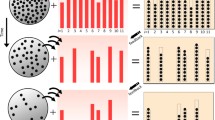Abstract
The principle of increasing entropy (PIE) is commonly considered as a universal physical law for natural systems. It also means that a non-equilibrium steady state (NESS) must not appear in any isolated natural systems. Here we experimentally investigate an isolated human social system with a clustering effect. We report that the PIE cannot always hold, and that NESSs can come to appear. Our study highlights the role of human adaptability in the PIE, and makes it possible to study human social systems by using some laws originating from traditional physics.
Similar content being viewed by others
References
A. H. Carter, Classical and Statistical Thermodynamics, New Jersey: Prentice Hall, 2000: 96
K. D. Bailey, Social Entropy Theory, State University of New York Press, New York, 1990
D. Challet and Y. C. Zhang, Emergence of cooperation and organization in an evolutionary game, Physica A, 1997, 246(3–4): 407
P. Jefferies, M. L. Hart, P. M. Hui, and N. F. Johnson, From minority games to real-world markets, Eur. Phys. J. B, 2001, 20(4): 493
M. Hart, P. Jefferies, P. M. Hui, and N. F. Johnson, Crowdanticrowd theory of multi-agent market games, Eur. Phys. J. B, 2001, 20(4): 547
D. Challet, M. Marsili, and Y. C. Zhang, Minority Games: Interacting Agents in Financial Markets, Oxford: Oxford University Press, 2005
R. Mantegna and H. E. Stanley, Introduction to Econophysics, Cambridge: Cambridge University Press, 2000
N. F. Johnson, P. Jefferies, and P. M. Hui, Financial Market Complexity, Oxford: Oxford University Press, 2003
M. Anghel, Z. Toroczkai, K. E. Bassler, and G. Korniss, Competition-driven network dynamics: Emergence of a scale-free leadership structure and collective efficiency, Phys. Rev. Lett., 2004, 92(5): 058701
K. Q. Yang, L. Yang, B. H. Gong, Z. C. Lin, H. S. He, and L. Huang, Geographical networks: Geographical effects on network properties, Front. Phys. China, 2008, 3(1): 105
L. Guo, Y. F. Chang, and X. Cai, The evolution of opinions on scale-free networks, Front. Phys. China, 2006, 1(4): 506
J. Zhou and Z. H. Liu, Epidemic spreading in complex networks, Front. Phys. China, 2008, 3(3): 331
C. M. Liu and J. W. Li, Small-world and the growing properties of the Chinese railway network, Front. Phys. China, 2007, 2(3): 364
S. Gheorghiu and M. Coppens, Heterogeneity explains features of “anomalous” thermodynamics and statistics, Proc. Natl. Acad. Sci. USA, 2004, 101(45): 15852
W. Wang, Y. Chen, and J. P. Huang, Heterogeneous preferences, decision-making capacity and phase transitions in a complex adaptive system, Proc. Natl. Acad. Sci. USA, 2009, 106(21): 8423
L. Pietronero, Statistical physics: Physicists get social, Nat. Phys., 2010, 6(9): 641
L. Zhao, G. Yang, W. Wang, Y. Chen, J. P. Huang, H. Ohashi, and H. E. Stanley, Herd behavior in a complex adaptive system, Proc. Natl. Acad. Sci. USA, 2011, 108(37): 15058
S. Gourley, S. C. Choe, P. M. Hui, and N. F. Johnson, Effects of local connectivity in a competitive population with limited resources, Europhys. Lett., 2004, 67(6): 867
R. T. Liu, F. F. Chung, and S. S. Liaw, Fish play minority game as humans do, Europhys. Lett., 2012, 97(2): 20004
P. Glansdorff and I. Prigogine, Thermodynamic Theory of Structure, Stability, and Fluctuations, UK: Wiley-Interscience, 1971
Y. Liang, K. N. An, G. Yang, and J. P. Huang, Contrarian behavior in a complex adaptive system, Phys. Rev. E, 2013, 87(1): 012809
W. B. Arthur, Inductive reasoning and bounded rationality, Am. Econ. Assoc. Papers Proc., 1994, 84: 406
C. E. Shannon, A mathematical theory of communication, Bell Syst. Tech. J., 1948, 27: 379
Y. Y. Yu, C. Xu, G. Q. Gu, and P. M. Hui, Spies in the minority game, Phys. Rev. E, 2008, 77(1): 011106
Y. Baek, S. H. Lee, and H. Jeong, The market behavior and performance of different strategy evaluation schemes, Phys. Rev. E, 2010, 82(2): 026109
S. Biswas, A. Ghosh, A. Chatterjee, T. Naskar, and B. K. Chakrabarti, Continuous transition of social efficiencies in the stochastic-strategy minority game, Phys. Rev. E, 2012, 85(3): 031104
S. Van Segbroeck, J. M. Pacheco, T. Lenaerts, and F. C. Santos, Emergence of fairness in repeated group interactions, Phys. Rev. Lett., 2012, 108(15): 158104
J. H. Kagel and A. E. Roth, The Handbook of Experimental Economics, New Jersey: Princeton University Press, 1995: 256–292
Author information
Authors and Affiliations
Corresponding author
Rights and permissions
About this article
Cite this article
Zheng, WZ., Liang, Y. & Huang, JP. Equilibrium state and non-equilibrium steady state in an isolated human system. Front. Phys. 9, 128–135 (2014). https://doi.org/10.1007/s11467-013-0337-5
Received:
Accepted:
Published:
Issue Date:
DOI: https://doi.org/10.1007/s11467-013-0337-5




